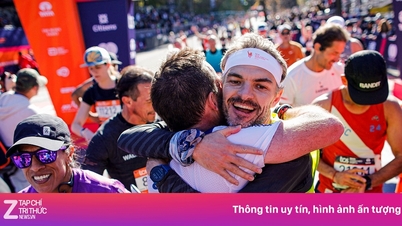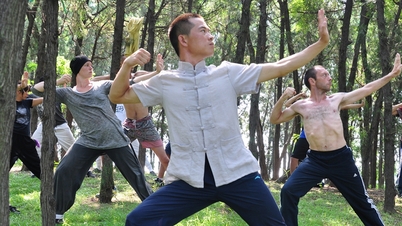
More and more fitness instructors are using social media - Photo: DW
Promising content on Tik Tok
“Flat belly in 7 days”, “How to squat 100 times a day”, “how to plank for 5 minutes”, “disappearing inner thighs”… A series of promising content leads those who want to exercise into the world of Tik Tok, or in general, the form of "online exercise".
The wave of following influencers exploded after the pandemic, when millions of people switched to exercising at home and continued to maintain this habit because it was cheap, convenient, and felt like "anyone could do it".
Many online exercise platforms report viewership and participation in “challenges” increasing by tens of percent each year.
But the benefits are not yet seen, the danger has often come.
In the UK, during the boom in home workouts, public health statistics recorded millions of cases of musculoskeletal problems during self-exercise, a significant portion of which were related to online classes or instructional videos.
On the gym side, recent surveys of hundreds of gym-goers also found that more than half have experienced at least one exercise-related injury – and the common thread is the lack of in-person coaching supervision, a factor very similar to the “learn by video ” scenario.

The episode content on Tik Tok is often very promising - Photo: DW
According to the British Health Service (NHS), hospitals, orthopedic and physiotherapy clinics have continuously received cases of injuries due to incorrect exercise over the years.
There are a series of common injuries such as: A series of lower back pain cases due to incorrect deadlift technique, knee pain due to squatting too deep, shoulder dislocation from push-up variations or box jumps according to clips, wrist sprains when doing one-arm push-ups, even falls when imitating acrobatic movements....
From a public health perspective, British health organizations have had to issue warnings after recording many cases of "home imitation" of performance movements that professional athletes perform in real life or at the Olympics.
High schools, universities, sports associations and training groups in the US and Europe have also spoken out about the "fitspiration" trend spreading online.
The content is compelling and promising, but many guides lack context, lack screening, and easily lead to newbies becoming overwhelmed, burned out, and traumatized.
In addition to musculoskeletal injuries, the downside also lies in mental health and nutrition.
“Fitspiration” creates a difficult-to-achieve body standard: flat stomach, thighs that don’t touch, V-shaped shoulders… Viewers easily compare, feel self-conscious, overwork to “follow the trend”, or fall into a spiral of rapid fat burning and extreme dieting.
Harvard University’s health blog has warned that “inspirational” content on social media can easily mix good tips with misinformation, promoting unhealthy eating and exercise behaviors. As a result, some viewers experience increased anxiety, sleep disturbances, or uncontrolled dieting after following the challenge.
Why is following TikTok more harmful than beneficial?
First, incorrect technique that no one corrects. With complex movements like deadlift, squat, lunge, overhead press, just a few degrees of deviation at the waist, knees or shoulders can cause pressure to be applied in the wrong direction, creating repetitive micro-injury.
Videos are often shot from “good” angles instead of “teaching” angles, so the practitioner cannot see the arched back, the inward-leaning knees, or the excessively bent wrists.
Second, the exercise is not suitable for your physical condition. Influencers are usually people who have a foundation of flexibility, strength, and endurance, while beginners lack muscle endurance and lack control of the body's axis (core, hips, pelvis, and knees).
Imitating advanced variations without mastering the basic version puts sudden load on the joints.
Third, the abbreviated video omits warm-up and recovery. While warm-up helps increase muscle heat, lubricate joints, and optimize neuromuscular receptors, this part is rarely emphasized because it is “less dramatic.”
After exercising, lack of stretching, water and electrolyte replenishment, and adequate sleep can lead to prolonged muscle pain and the risk of chain injuries.

Imitating celebrities has many downsides - Photo: ASIAONE
Fourth, crowd psychology and digital ego. Wanting to shoot a good clip or complete a popular challenge, many people try to exceed their safety threshold, considering pain as “normal”, until they rupture a tendon or herniate a disc.
International experts have repeatedly emphasized this. The American Academy of Sports Medicine (ACSM) recommends that the core of safe training is individualization: gradually increasing the maximum volume by 10% per week, prioritizing technique, and having rest-recovery cycles.
The National Strength and Conditioning Association (NSCA) requires that free weight practitioners learn proper form, use appropriate weights, and have supervision when pushing and pulling heavy weights.
Physical therapists also note high-risk movements for beginners: deep and heavy squats when the hamstrings are not flexible enough or the hips are not controlled; deadlifts without keeping the back neutral; push-ups/shoulder press-ups when the front shoulders are weak and the scapula is unstable; or high plyometric jumps when the thighs, glutes, and calves do not have basic strength...
Source: https://tuoitre.vn/tap-the-duc-theo-tik-tok-loi-hay-hai-20250808220508426.htm



![[Photo] Prime Minister Pham Minh Chinh launched a peak emulation campaign to achieve achievements in celebration of the 14th National Party Congress](https://vphoto.vietnam.vn/thumb/1200x675/vietnam/resource/IMAGE/2025/10/5/8869ec5cdbc740f58fbf2ae73f065076)


![[Photo] Prime Minister Pham Minh Chinh chairs the Government's online conference with localities](https://vphoto.vietnam.vn/thumb/1200x675/vietnam/resource/IMAGE/2025/10/5/264793cfb4404c63a701d235ff43e1bd)





















































![[VIDEO] Summary of Petrovietnam's 50th Anniversary Ceremony](https://vphoto.vietnam.vn/thumb/402x226/vietnam/resource/IMAGE/2025/10/4/abe133bdb8114793a16d4fe3e5bd0f12)

![[VIDEO] GENERAL SECRETARY TO LAM AWARDS PETROVIETNAM 8 GOLDEN WORDS: "PIONEER - EXCELLENT - SUSTAINABLE - GLOBAL"](https://vphoto.vietnam.vn/thumb/402x226/vietnam/resource/IMAGE/2025/7/23/c2fdb48863e846cfa9fb8e6ea9cf44e7)





































Comment (0)